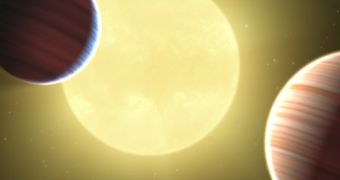Among the 400 candidate planets identified by space-based Kepler telescope, there are two Saturn-sized planets that cross in front of, or transit the same star, NASA announced yesterday, and published the discovery in the journal Science.
The space telescope captured the transit signatures of the two planets in the data for the sun-like star called Kepler-9, and so the planets were named Kepler-9b and Kepler-9c.
These findings come after seven months of observation of over 156,000 stars, within the search for Earth-sized planets beyond our solar system.
Also, in June, when NASA announced 706 potential exoplanets and released data for only 306 of them, it underwent a lot of criticism, but apparently it allowed its scientists to gather enough follow-up data to have confirmed results, as well as the discovery of a multi-planet system.
The Kepler telescope, was launched in March 2009, and it detects exoplanets by looking for a periodic dimming in stellar brightness, which means planets are transiting the star.
It also has confirmed the first observation of a gravitational battle between neighboring exoplanets, which allowed astronomers to calculate the planets' masses, and investigate the formation and evolution of these alien solar systems.
“Kepler's high quality data and round-the-clock coverage of transiting objects enable a whole host of unique measurements to be made of the parent stars and their planetary systems,” said the Kepler program scientist at NASA Headquarters in Washington, Doug Hudgins.
Before, for finding out the masses of such planets, astronomers relied on radial velocity observations that gave the degree to which the gravitational pull of the planet perturbs the star that it orbits.
This was problematic as the measurements depend on the inclination of the planet’s orbit, which isn’t well known.
Now, if the gravitational influence on each other of two exoplanets orbiting the same star is strong enough and the time of transit is not periodic, scientists can precisely calculate their masses.
Lead author Matthew Holman from the Harvard-Smithsonian Center for Astrophysics in Cambridge, Massachusetts says the changes in the transit times of these two planets are caused by the fact that one of the planets orbits the star in almost exactly half of the time that it takes the other.
Scientists have worked on a much precise estimation of the masses of the planets using observations from the W.M. Keck Observatory in Hawaii.
The data show Kepler-9b is the larger of the two planets, even though both planets' masses are slightly less than Saturn's.
Kepler-9b lies closest to the star with it orbits in about 19 days, while Kepler-9c has a longer orbit of nearly 38 days.
Further research and calculations should give more precise figures and Holman even says that “we will know the masses [of these planets] better than any planet outside of our Solar System.”
He adds that “this discovery is the first clear detection of significant changes in the intervals from one planetary transit to the next, what we call transit timing variations, and this is evidence of the gravitational interaction between the two planets as seen by the Kepler spacecraft.”
Besides the two exoplanets, Kepler has also found what seems to be a third, much smaller transit signature in the observations of Kepler-9, of a possible super-Earth-sized planet, 1.5 times larger than ours, which has a 1.6 day orbit.
Further information are necessary to establish if this is really a planet or simply an astronomical phenomenon that imitates the appearance of a transit.

 14 DAY TRIAL //
14 DAY TRIAL //